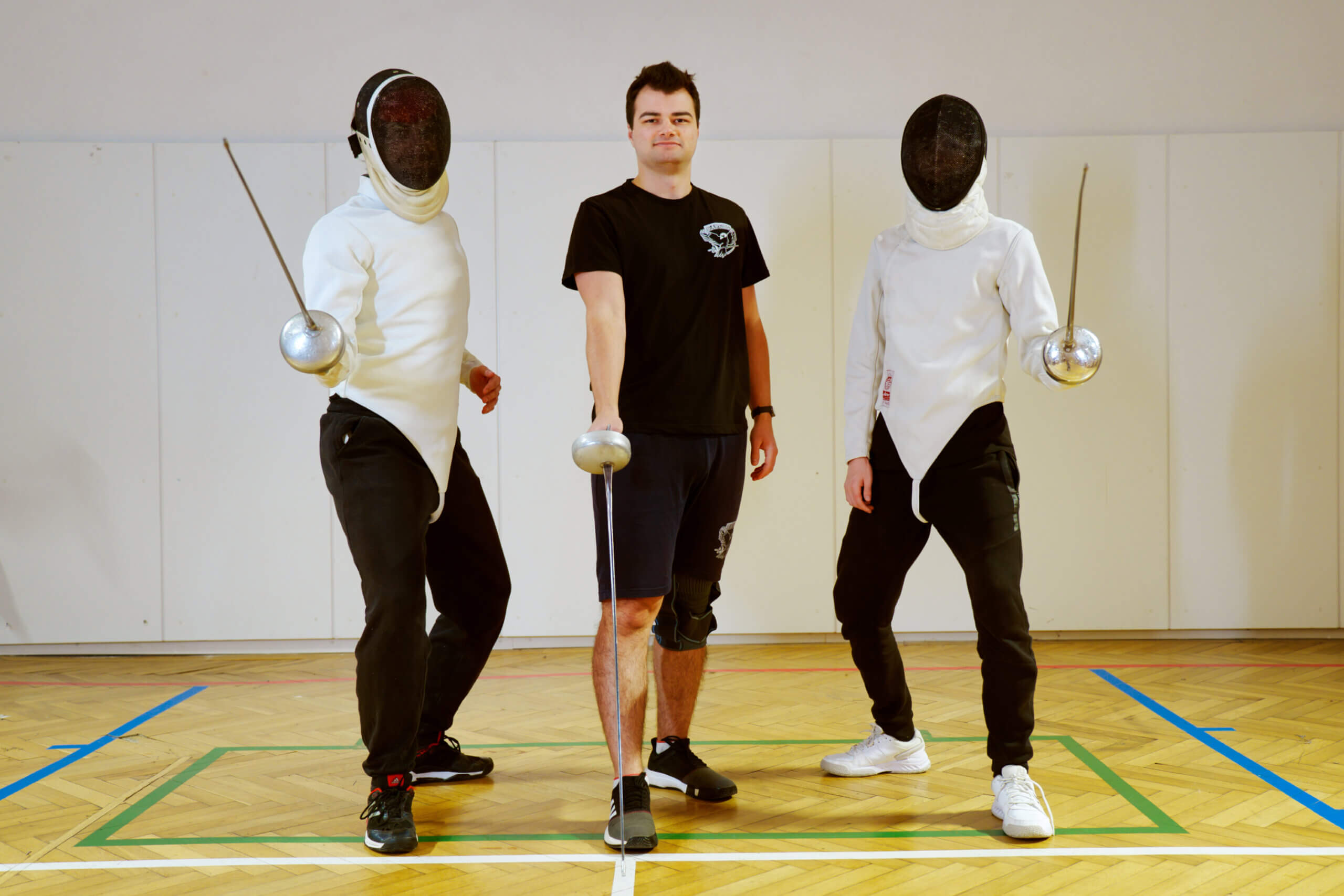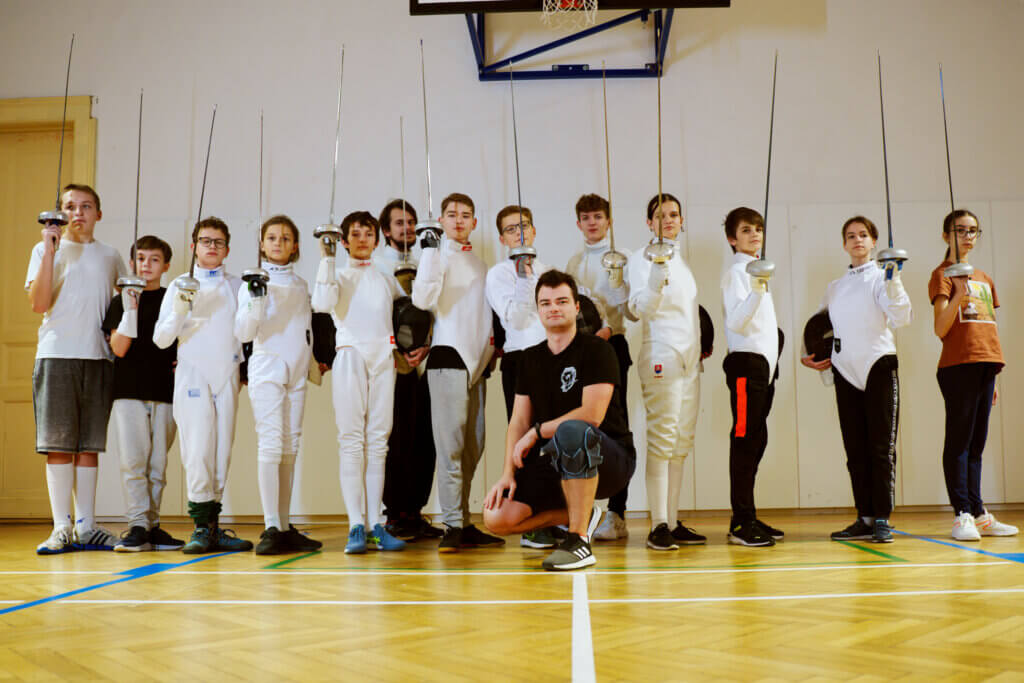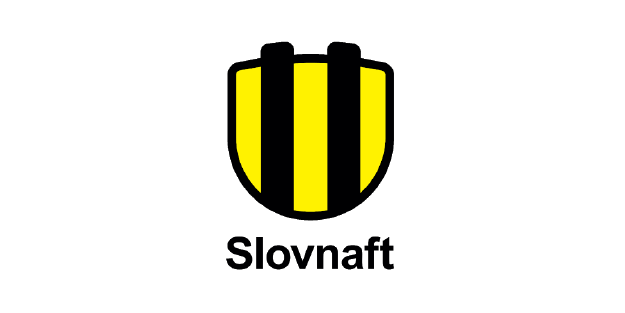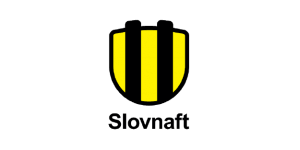One of the projects we have supported is a fencing club in Košice. Our colleague Oleksii Krynytskyi is a member of the club, and we interviewed him about the beauty of this Olympic sport and its specific features. He comes from Uzhhorod and has been in Slovakia since 2017.
Fencing is one of the oldest sports, although at different times it has represented everything from the protection of life, the refinement of the upper class to today’s Olympic prestige. How do you perceive fencing as such?
A lot of it depends on the person himself and how the sport grows close to his heart and soul. I’ve been dreaming about fencing since I was in kindergarten, we had these plastic cords with masks, and I always wanted to stab something. Then it passed me by for a while, until I saw a commercial on TV about fencing and the uniqueness of fencers. That’s when I picked up a wooden sack, took the D’Artagnan stance, and when my mom noticed, she put me in fencing and that’s where my fencing career began, and that’s where it’s kept me going without a break ever since.
Do you like old movies with that theme?
Yes, but there it was all about one winning point, which many times ended the duel with the death of one of the actors. In today’s sport, there are more points at stake, there is more fun.
Speaking of points, what all does a fencer need to master to win?
First of all, it has to be an artist who does not perceive the whole surroundings and perceives only the path on the planche (guide rope). You have to perceive the distances between you and your opponent who constantly wants to deceive you, which of course is your plan. You come up with actions with many steps, which you then execute, and it’s all literally in seconds, even fractions of seconds. It’s managing all the processes at once, you have to almost control your feet automatically, so you don’t have to think about it at all. It’s an interplay of movements, tactics, reactions to your opponent, and analysis of absolutely all the variations that can occur. It’s a kind of chess game in your head, and it’s all moving fast.
There are several categories in fencing. What do you tend to gravitate towards the most?
There are 3 categories. The sword, the sabre and my favourite, the foil. They are all in the programme of the Olympic Games and the difference is in the hit zones and the style of fencing. If you take sword for example, it is slower but more technical. You’re looking for little mistakes from your opponent that you have to exploit quickly. Foil fencing is more dynamic, and as an example, once when I was down 4:14, I was able to eventually win 15:14, which is practically impossible in cord. And sabre is quite specific because you don’t stab there, you just chop your opponent, so you just touch a valid surface on your opponent’s clothing.
Speaking of scoring, I’ve seen many times in the Olympics that a point was scored by both opponents against each other. How is that possible when everything is electronically controlled nowadays?
It’s also about how the referee will see it. Not only who scored first, but also who went on the attack first. If a fencer went on the attack half a second before his opponent, for example, he has the advantage for the same jab. However, this only applies to the foil and the sabre. With a cord, two stab at the same time and two have points as well.
We already mentioned that your favourite is the foil.
Yeah. It’s a fast game, action after action, you’re always trying something with your opponent. For example, with a cord, nothing has to happen for half a minute and you’re just trying not to make a mistake on the planche. In terms of fun, foil fencing is definitely more attractive.
Is it possible to compare fencing in Slovakia and Ukraine?
First of all, I have to say that I am very sorry that fencing in Slovakia is at a much lower level and is not as popular as it was in Ukraine. Whereas, for example, the neighbouring Hungarians are among the world’s top fencers. On the other hand, I have to say that we are already developing some outstanding personalities in Slovakia who could make a significant impact on the world scene in the near future. There are a few clubs here, but in Ukraine I had 80 excellent fencers in my category, and it was very difficult to get into the higher elimination fights. If someone wanted to get to the semi-finals, they had to work very hard for it. When I came here, there were at most 10 fencers, and it didn’t take much effort to get a medal.
Before you moved to Slovakia, you were a very successful athlete in Ukraine.
There was a ranking of the top 16 fencers in Ukraine and only they always got an invitation to a kind of tournament of the country’s champions at the end of the year. It was something more than the championship of Ukraine and here I managed to get a bronze medal.
So, when you came to Slovakia, were you the best?
That depends. I wasn’t allowed to compete anywhere, so I didn’t even have anyone to compare myself with, as I don’t have citizenship yet. Unfortunately, they didn’t give me any advantages. Maybe if I had trained harder, I would have won the gold.
In Košice you are a coach at the Ravens Košice club, you are the head coach there. Try to compare the training processes in Košice with those in the world.
First of all, it has to be said that times have changed. When I was young and the coach said something, it was the word of God and the law at the same time. Nowadays, when I explain something and try to correct the mistakes of my pupils, often it’s like talking to a brick wall. We have two or three fencers who listen, but that’s not enough. But I still feel that the kids in Ukraine, for example, are much more disciplined and have more respect for the coach. It is not just us, a friend of mine you trains in Germany told me the same thing. As far as training methods are concerned, today, as in every other sport, they are flying at breakneck speed, and it is difficult to follow trends.
You mentioned that you have some good fencers.
Yes, we have some multiple Slovak champions and some who have competed in the World Cup. At the moment I have one student who you can see that she not only wants to be good, but she also wants to be a coach in the future.
So where does Slovak fencing stand in comparison to other countries?
Historically, Italy is the leader and then the countries that run out with some good fencers change. However, nowadays Slovakia also has some excellent fencers who are showing great potential in the world. So far they are in the junior category. They train in Bratislava, they have an excellent coach Jozef Nagy, and it must be said that in their categories they are the world’s best. So we have started at a very good pace in Slovakia, but it all depends on the individual, how he wants to do it and what his plans are.
When should one start fencing and who is fencing for?
Ideally at the age of seven, but it can be earlier. It is an individual sport full of precise exercises and, for many, monotonous repetitions to the point of frenzy so that the individual becomes absolutely perfect in the individual acts. This means that sometimes there is nothing else to do in training other than stabbing 500 times in a certain spot. It’s about automating processes, pacing, stances, attacks. If a kid likes to run and he is too active, then you need to look more like soccer or tennis.
How much does it cost to become a fencer?
Well, this is the harder side of the sport, it’s certainly not cheap. First and foremost, you need to have a suit that can withstand 350 Nm of pressure so that it doesn’t break and cause injury. If you want even higher quality stuff that lasts longer and is essential for FIE (Fencing International Federation) competitions, it costs even more. A training gun is about €150, but that FIE gun is worth €800 and is rated for about 300 stabs. The blade may break sooner or later, but every time you hear the sound of the blade breaking, you can feel the money coming out of your pocket. Well, and the suit also starts at €300, but you can buy only a vest for €800, plus you have to buy the mask, etc. So the gear for the kids is about €1,000 and for the FIE races €3,000.
What does the weapon itself look like? Is there a ball on the end or a sharp edge?
There’s no ball, and you can’t call it a sharp edge either, because there’s a kind of switch that when you stab and push it, it gives a signal that you’ve been hit, then it locks the way, and the light comes on. And if we’re talking about individual guns, the foil weighs about 500g and the cord weighs 750g, which is also quite a challenge to hold in your hand during training and competition. The springs in the blades are set to this weight as well.
What other sporting ambitions do you have?
I would definitely like to fence for Slovakia and go to European tournaments as soon as possible. It’s my dream and my biggest passion, so any chance I get, I want to take it and make the most of it. I want to improve, bring more to my students and learn from the best, and that’s what the opportunity at big tournaments is all about.
Can fencing be done recreationally?
Of course. We have parents who started training at the age of 50 and they’ve done quite well. We can’t talk about great achievements but it’s interesting to watch them. Even weight is not a problem, in that respect it’s more a problem to find a suit of a size that fits the figure.
Is it possible to get injured while fencing?
Common bruises and minor scratches are normal, but before safety standards were so sophisticated, for example, I know of a fatality in 1982. It was caused by a broken blade, which was very sharp, and a poor quality helmet, whereby a fencer from Germany pierced the mask and aimed directly at his opponent’s eye.
Thank you for the interview.


































